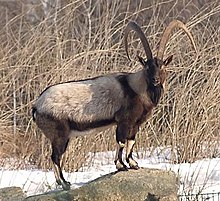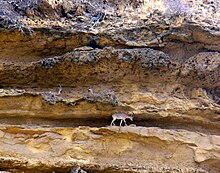Дикий коз
| Дикий коз Временный диапазон: Плейстоцен - недавний
| |
|---|---|

| |
| Bezoar Ibex , Capra aegagrus aegagrus | |
| Scientific classification | |
| Domain: | Eukaryota |
| Kingdom: | Animalia |
| Phylum: | Chordata |
| Class: | Mammalia |
| Order: | Artiodactyla |
| Family: | Bovidae |
| Subfamily: | Caprinae |
| Tribe: | Caprini |
| Genus: | Capra |
| Species: | C. aegagrus
|
| Binomial name | |
| Capra aegagrus Erxleben, 1777
| |
| Subspecies | |
|
Capra aegagrus aegagrus | |
Дикий козел ( Capra Aegagrus ) - это дикий козы , населяющий леса, кустарники и скалистые районы, начиная от Турции и Кавказа на западе до Туркменистана , Афганистана и Пакистана на востоке. Он был указан как почти угрожающий в красном списке МСОП , и ему угрожают разрушение и деградация среды обитания. [ 1 ]
Считается, что он является предком домашнего козла ( C. hircus ). [ 2 ]
Таксономия
[ редактировать ]Катра Аэгграс была первым научным названием , предложенным Иоганном Кристиан Поликарп Эркслбен в 1777 году для популяций диких коз в гор Кавказа и Тельца . [ 3 ] Катра Блайти (предложенная Алланом Октавином Юмом в 1874 году) была передана диким рогам коз, найденным у Синда . [ 4 ]
Следующие подвиды диких коз считаются действительными таксонами: [ Цитация необходима ]
- Bezoar Ibex C. a. Иагагус
- Синд Ибекс С. а. Блайт
- Chiltan ibex C. a. chialtanensis
- Turkmen wild goat C. a. turcmenica
The Cretan goat (formerly C. a. pictus), or kri-kri, was once thought to be a subspecies of wild goat, but is now considered to be a feral descendant of the domestic goat (Capra hircus), now known as Capra hircus cretica.
Distribution and habitat
[edit]


In Turkey, the wild goat occurs in the Aegean, Mediterranean, Black Sea, Southeastern and the Eastern Anatolia Regions up to 4,500 m (14,800 ft) in the Taurus and Anti-Taurus Mountains.[citation needed]
In the Caucasus, it inhabits montane forests in the river basins of Andi Koysu and its tributaries in Dagestan, Chechnya and Georgia up to 2,700 m (8,900 ft).[5][6]
In Armenia, wild goats were recorded in the Zangezur Mountains, in Khosrov State Reserve, and in highlands of the Syunik Province during field surveys from 2006 to 2007.[7] In Azerbaijan, wild goats occur in Ordubad National Park, Daralayaz and Murovdag mountain areas in Nakhchivan Autonomous Republic.[8] In Iran's Haftad Gholleh Protected Area, wild goat herds live foremost in west-facing areas with rocky substrates, water sources and steep slopes that are far from roads.[9] In Turkmenistan, wild goat populations inhabit the mountain ranges of Uly Balkan[1] and Kopet Dag.[10] In Pakistan, wild goat herds occur in Kirthar National Park.[11]
Behaviour and ecology
[edit]In Kirthar National Park, 283 wild goat groups were observed for 10 months in 1986. The group sizes ranged from two to 131 individuals but varied seasonally, with a mean ratio of two females per male.[11]
In Dagestan, male wild goats start courting females in mid December. The rutting season lasts until the third week of January. Females give birth to between one and three kids in late June to mid July.[6]
Older males drive younger males from the maternal herds. The gestation period averages 170 days. Kids are mobile almost immediately after birth. Kids are weaned after 6 months. Female goats reach sexual maturity at 1½–2½ years, males at 3½–4 years. The lifespan of a goat can be from 12 to 22 years.
Threats
[edit]Wild goat populations are threatened foremost by poaching, habitat loss due to logging, and competition with domestic livestock for food resources.[1]
See also
[edit]References
[edit]- ^ Jump up to: a b c d Weinberg, P.; Ambarli, H. (2020). "Capra aegagrus". IUCN Red List of Threatened Species. 2020: e.T3786A22145942. doi:10.2305/IUCN.UK.2020-2.RLTS.T3786A22145942.en. Retrieved 9 February 2022.
- ^ Mannen, H.; Nagata, Y.; Tsuji, S. (2001). "Mitochondrial DNA reveal that domestic goat (Capra hircus) are genetically affected by two subspecies of bezoar (Capra aegagurus)". Biochemical Genetics. 39 (5−6): 145−154. doi:10.1023/A:1010266207735. PMID 11530852. S2CID 24146711.
- ^ Erxleben, J. C. P. (1777). "Capra aegagrus". Systema regni animalis per classes, ordines, genera, species, varietates cvm synonymia et historia animalivm. Classis I. Mammalia. Lipsiae: Weygandt. pp. 520–521.
- ^ Hume, A. C. (1874). "Note on two apparently undescribed species of Goat from Northern India and a new species of Dove from the Nicobar Islands". Proceedings of the Asiatic Society of Bengal (December): 240–241.
- ^ Akhmedov, E. G.; Yarovenko, Y. A.; Nasrullaev, N. I.; Babaev, E. A.; Akhmedov, S. G. (2009). "Conservation of the Bezoar Goat in the Eastern Caucasus". In Zazanashvili, N.; Mallon, D. (eds.). Status and Protection of Globally Threatened Species in the Caucasus (PDF). Tbilisi: CEPF, WWF. pp. 26−31.
- ^ Jump up to: a b Weinberg, P. (2014). "On the status and biology of the wild goat in Daghestan (Russia)". Journal of Mountain Ecology. 6 (6): 31−40.
- ^ Khorozyan, I. G.; Weinberg, P. I.; Malkhasyan, A. G. (2009). "Conservation Strategy for Armenian Mouflon (Ovis [orientalis] gmelini Blyth) and Bezoar Goat (Capra aegagrus Erxleben) in Armenia". In Zazanashvili, N.; Mallon, D. (eds.). Status and Protection of Globally Threatened Species in the Caucasus (PDF). Tbilisi: CEPF, WWF. pp. 37−45.
- ^ Talibov, T. H.; Weinberg, P. I.; Mammadov, I. B.; Mammadov, E. N.; Talibov, S. T. (2009). "Conservation Strategy of the Asiatic Mouflon (Ovis [orientalis] gmelini Blyth) and the Bezoar Goat (Capra aegagrus Erxleben) in Azerbaijan". In Zazanashvili, N.; Mallon, D. (eds.). Status and Protection of Globally Threatened Species in the Caucasus (PDF). Tbilisi: CEPF, WWF. pp. 46−52.
- ^ Esfandabad, BS; Карами, М.; Хемами, MR; Riazi, B. & Sadough, MB (2010). «Ассоциации среды обитания дикого коз в центральном Иране: последствия для сохранения» (PDF) . Европейский журнал исследований дикой природы . 56 (6): 883–894. doi : 10.1007/s10344-010-0386-9 . S2CID 23188666 . [ мертвая ссылка ]
- ^ Коршунов, В.М. (1994). «Экология бородатой козы ( Capra aegagrus erxleben 1777) в Туркменистане». Биогеография и экология Туркменистана . Monographiae Biologicae. Тол. 72. Дордрехт: Спрингер. С. 231–246.
- ^ Jump up to: а беременный Edge, WD & Olson-Edge, SL (1990). «Характеристики населения и групповой состав Капра Эгграс в национальном парке Киртхар, Пакистан». Журнал млекопитающих . 71 (2): 156–160. doi : 10.2307/1382162 . JSTOR 1382162 .
Внешние ссылки
[ редактировать ]- « Capra Aegagrus : видео, фотографии и факты диких коз» . Аркив . Архивировано с оригинала 2017-06-12 . Получено 2017-06-18 .
- «Крит дикий козей Капра Аэгграс Критика » . Всемирная ассоциация зоопарков и аквариумов . Архивировано с оригинала 2016-10-17 . Получено 2017-06-18 .
- Красный список МСОП
- Млекопитающие, описанные в 1777 году
- Таксоны, названные Иоганном Кристиан Поликарп Эркслбен
- Коз (гонка)
- Козы
- Фауна Ирана
- Фауна Джамму и Кашмира
- Млекопитающие Центральной Азии
- Млекопитающие Азербайджана
- Млекопитающие Европы
- Млекопитающие Пакистана
- Существующий плейстоцен первые появления
- Директивы среды обитания
